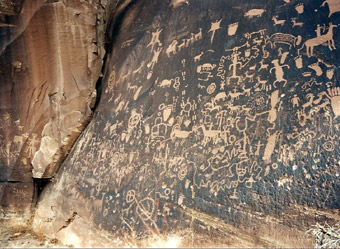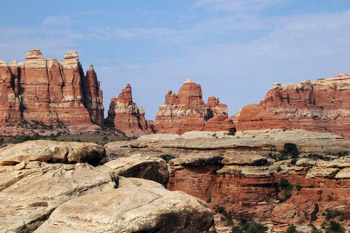See our Moab area overview and Moab area hikiing articles.
Newspaper Rock, Indian Creek and Canyonlands National Park
Follow the Red Rock Road to Some of Utah's Most Spectacular Sites
By Sonja McClure

Southern Utah is a vast land filled with natural cities of spires, soft sculpted statues and rock art panels. Exploring these old surroundings gives one a deeper sense of Utah's history. How these landmarks survived the harsh elements all these years, standing firm through heat, wind and rain, and still exist today is impressive.
On a sunny spring day, our group of five drives 40 miles south of Moab on U.S. 191 and turns off at Hwy. 211, towards Canyonlands National Park. About 10 miles down the road we reach Newspaper Rock, one of the largest and easily accessible petroglyphs (images etched into stone) sites in Utah. From the parking lot, it is a short ¼-mile trail to the wall. Picnic areas are available, but no water.
This rock art wall is exceptionally unique because of its large collection of markings and its size, about 8 ft high and 20 ft wide. Some of the etchings date back 2,000 years ago. Among the desert tribes that marked the wall, were the Anasazi, Fremont, Paiute, and Navajo.
Some of the images we study on the scripted wall are footprints, wild animals and the arrival of the settlers are recorded with wagon wheels and horses. Like a bulletin board, the rock was a place where people could communicate messages with others. Those ancient inscriptions were some of the earliest recordings of written communication. Nowadays we take for granted that we have instant communication with others, unlike the Indians who had to travel to send or receive messages.
4.5-miles beyond Newspaper Rock, Indian Creek begins. A gold mine for crack climbers, 1,000s of rock climbing routes reside in this area. Crack climbing requires a different technique from regular rocking climbing. Normally one uses external rocks or cliff edges for handholds as you climb. With crack climbing, you actually insert or jam your hands or fists into the cracks of the wall giving you leverage as you climb. Most all of the routes in Indian Creek are rated difficult, requiring proper gear and skill.
The area my friends decide to climb is the 4 x 4 wall where all the routes are named after 4 x 4 vehicle parts. They choose to climb Crankcase. Lacking the skill needed for this climb, I decide to watch my friends rather than participate. The two of them take turns climbing the 100 ft rock face. Slowly but surely, they make their ascent over inverted ledges and whatever obstacles come their way. Scratching knuckles and palms as they scale the wall, their muscles burning, rock climbing is a total workout from shoulders to feet. The endurance and fearlessness they display is inspiring.
Sunset hits and we retreat to our camp. We make sure not to camp in the areas that are private land and pick a pre-existing site. Free camping is available in the Bridger Jack and Creek Pasture sections. The only primitive bathroom in the area is at Newspaper Rock.
The next day, before we enter the National Park, we veer off Hwy. 211 onto the Lockhart Basin Rd to secure a remote campsite for that evening. Not much shade is found, but being so close to the park entrance is a plus and makes up for the barren campsite.

Once inside Canyonlands, we park at Elephant Hill where the Chesler Park trailhead begins. Only experienced drivers in four-wheel drive vehicles should continue up Elephant Hill.
The hike to Chesler Park is 6 miles roundtrip. The trail is marked on the side with cairns showing the way. Lizards are constant companions on the trail. I like traversing the tall narrow walkway with man made stone stairs.
The trail opens into clusters of multicolored hoodoos, ranging from 6-50 ft tall, glowing in the sunlight. Some shapes look like large mushrooms, others create a skyline of skinny totem poles. The rounded curvature of the coral colored rock looks so smooth and has to the eye an aesthetic appeal that other jagged rock formations lack. Like a fine chiseled statue, the sandstone beckons to be touched.
The terrain varies slightly as we gain and lose elevation along the way. The view of the La Sal Mountains, with the red rock figures in the forefront, is breathtaking. Looking to the west, the Henry Mountains peak out.
We stop along the way to have a bite to eat. Above us in a tree, we notice a few Blue Jays perched. I throw a few breadcrumbs on the ground and sure enough, they swoop down, pick up the bait with their beaks, and fly back to the safety of the tree.
All our hiking efforts pay off when we reach the glorious grasslands within the valley of the spires. We find at least three campsites and wish we had obtained a backpacking permit for camping in this beautiful setting. Not far from there, we discover remnants of old cowboy camps.
Sun drained yet satisfied we return to our car. Back at our camp, we build a nice fire and cook dinner using Dutch ovens.
We relax under the canopy of stars and listen to the fire crackle. We notice something moving on the ground at the fires edge. A few tailless scorpions have invaded our camp. My friend informs me they are harmless, unable to sting like normal scorpions. Regardless of their inability to sting, they still look scary so I keep a special watch for more to come. We seal up the tent when we retire to keep out the critters.
With the advancement of civilization, Newspaper Rock and Canyonlands seem so primitive. Yet that is the whole appeal and the very reason we choose to come here. I hope these preserved places in the outdoors will remain, as they've always been, simple and sacred. The desert has an abundance of beauty waiting around every corner. Exploring the unfamiliar brings me great pleasure.
About the author: I am a writer who enjoys the outdoors, travel and dance. I am a University of Utah graduate with a degree in Communication. I have lived in Washington, which is like a second home to me. I have explored Southern Utah for the past 10 years in areas such as, Lake Powell, Capital Reef, Goblin Valley and Moab.
Copyright Sonja McClure
